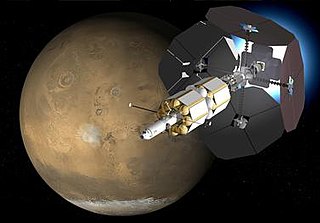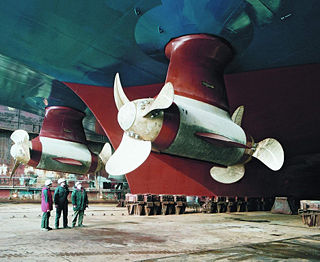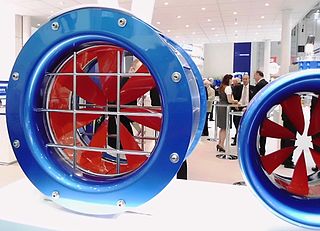
A magnetoplasmadynamic (MPD) thruster (MPDT) is a form of electrically powered spacecraft propulsion which uses the Lorentz force to generate thrust. It is sometimes referred to as Lorentz Force Accelerator (LFA) or MPD arcjet.
A pulsed plasma thruster (PPT), also known as a plasma jet engine, is a form of electric spacecraft propulsion. PPTs are generally considered the simplest form of electric spacecraft propulsion and were the first form of electric propulsion to be flown in space, having flown on two Soviet probes starting in 1964. PPTs are generally flown on spacecraft with a surplus of electricity from abundantly available solar energy.
A fusion rocket is a theoretical design for a rocket driven by fusion propulsion which could provide efficient and long-term acceleration in space without the need to carry a large fuel supply. The design relies on the development of fusion power technology beyond current capabilities, and the construction of rockets much larger and more complex than any current spacecraft. A smaller and lighter fusion reactor might be possible in the future when more sophisticated methods have been devised to control magnetic confinement and prevent plasma instabilities. Inertial fusion could provide a lighter and more compact alternative, as might a fusion engine based on an field-reversed configuration. Fusion nuclear pulse propulsion is one approach to using nuclear fusion energy to provide propulsion for rockets.

A pulsed inductive thruster (PIT) is a form of ion thruster, used in spacecraft propulsion. It is a plasma propulsion engine using perpendicular electric and magnetic fields to accelerate a propellant with no electrode.

The Variable Specific Impulse Magnetoplasma Rocket (VASIMR) is an electrothermal thruster under development for possible use in spacecraft propulsion. It uses radio waves to ionize and heat an inert propellant, then a magnetic field to accelerate the resulting plasma, generating thrust. It is a plasma propulsion engine, one of several types of spacecraft electric propulsion systems.

Propulsion means to push forward or drive an object forward. The term is derived from two Latin words: pro, meaning before or forward; and pellere, meaning to drive. A propulsion system consists of a source of mechanical power, and a propulsor.
Field-emission electric propulsion (FEEP) is an advanced electrostatic space propulsion concept, a form of ion thruster, that uses liquid metal as a propellant. A FEEP device consists of an emitter and an accelerator electrode. A potential difference of the order of 10 kV is applied between the two, which generates a strong electric field at the tip of the metal surface. The interplay of electric force and surface tension generates surface instabilities which give rise to Taylor cones on the liquid surface. At sufficiently high values of the applied field, ions are extracted from the cone tip by field evaporation or similar mechanisms, which then are accelerated to high velocities.

A magnetohydrodynamic drive or MHD accelerator is a method for propelling vehicles using only electric and magnetic fields with no moving parts, accelerating an electrically conductive propellant with magnetohydrodynamics. The fluid is directed to the rear and as a reaction, the vehicle accelerates forward.

Laser propulsion is a form of beam-powered propulsion where the energy source is a remote laser system and separate from the reaction mass. This form of propulsion differs from a conventional chemical rocket where both energy and reaction mass come from the solid or liquid propellants carried on board the vehicle.

The gridded ion thruster is a common design for ion thrusters, a highly efficient low-thrust spacecraft propulsion running on electrical power. These designs use high-voltage grid electrodes to accelerate ions with electrostatic forces.
Jet propulsion is the propulsion of an object in one direction, produced by ejecting a jet of fluid in the opposite direction. By Newton's third law, the moving body is propelled in the opposite direction to the jet. Reaction engines operating on the principle of jet propulsion include the jet engine used for aircraft propulsion, the pump-jet used for marine propulsion, and the rocket engine and plasma thruster used for spacecraft propulsion. Biological systems include the propulsion mechanisms of certain marine animals such as cephalopods, sea hares, arthropods, and fish.

Manoeuvring thruster is a transversal propulsion device built into, or mounted to, either the bow or stern, of a ship or boat to make it more manoeuvrable. Bow thrusters make docking easier, since they allow the captain to turn the vessel to port or starboard side, without using the main propulsion mechanism which requires some forward motion for turning; The effectiveness of a thruster is curtailed by any forward motion due to the Coandă effect. A stern thruster is of the same principle, fitted at the stern. Large ships might have multiple bow thrusters and stern thrusters.

A plasma propulsion engine is a type of electric propulsion that generates thrust from a quasi-neutral plasma. This is in contrast to ion thruster engines, which generate thrust through extracting an ion current from plasma source, which is then accelerated to high velocities using grids/anodes. These exist in many forms. Plasma thrusters do not typically use high voltage grids or anodes/ cathodes to accelerate the charged particles in the plasma, but rather uses currents and potentials which are generated internally in the plasma to accelerate the plasma ions. While this results in a lower exhaust velocity by virtue of the lack of high accelerating voltages, this type of thruster has a number of advantages. The lack of high voltage grids of anodes removes a possible limiting element as a result of grid ion erosion. The plasma exhaust is 'quasi-neutral', which means that ion and electrons exist in equal number, which allows simply ion-electron recombination in the exhaust to neutralise the exhaust plume, removing the need for an electron gun. This type of thruster often generates the source plasma using radio frequency or microwave energy, using an external antenna. This fact, combined with the absence of hollow cathodes allows the intriguing possibility of being able to use this type of thruster on a huge range of propellants, from argon, to carbon dioxide, air mixtures, to astronaut urine.

An electrically-powered spacecraft propulsion system uses electrical, and possibly also magnetic fields, to change the velocity of a spacecraft. Most of these kinds of spacecraft propulsion systems work by electrically expelling propellant at high speed.
A reaction engine is an engine or motor that produces thrust by expelling reaction mass, in accordance with Newton's third law of motion. This law of motion is most commonly paraphrased as: "For every action force there is an equal, but opposite, reaction force."
Schottel is a manufacturer of propulsion and steering systems for ships and offshore applications. The company founder Josef Becker invented the rudderpropeller, a z-drive, in 1950. Today the company develops and manufactures azimuth propulsion, maneuvering and steering systems. In 2014 the subsidiary Schottel Hydro was founded to bundle up the company activities in the hydrokinetic energy segment.
thruster is a propulsive device used by spacecraft for station keeping, attitude control, in the reaction control system, or long-duration, low-thrust acceleration. A vernier engine or gimbal engine is a particular case used on launch vehicles where a secondary rocket or other high thrust device is used to control the attitude of the rocket while the primary thrust engine is fixed to the rocket and supplies the principal amount of thrust.


















